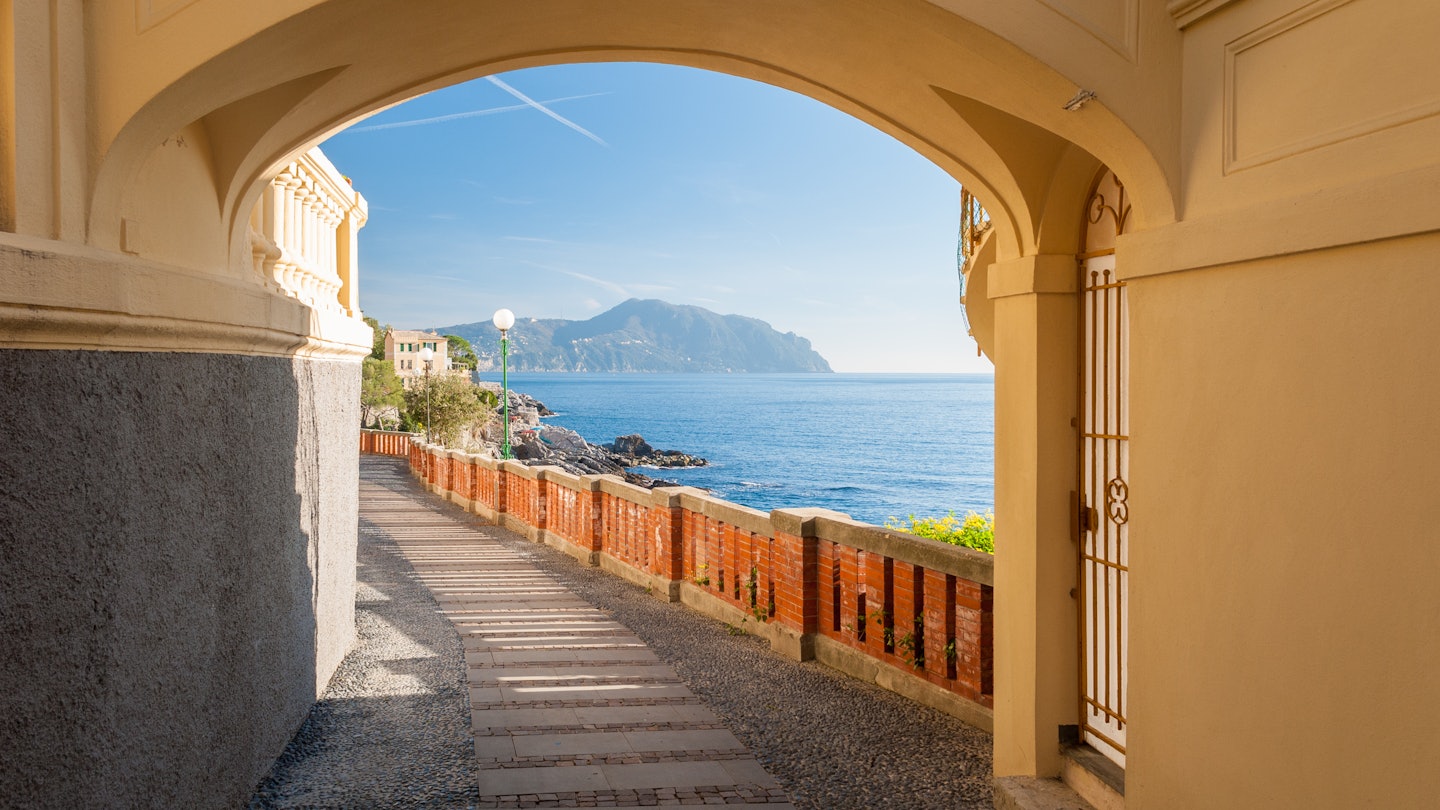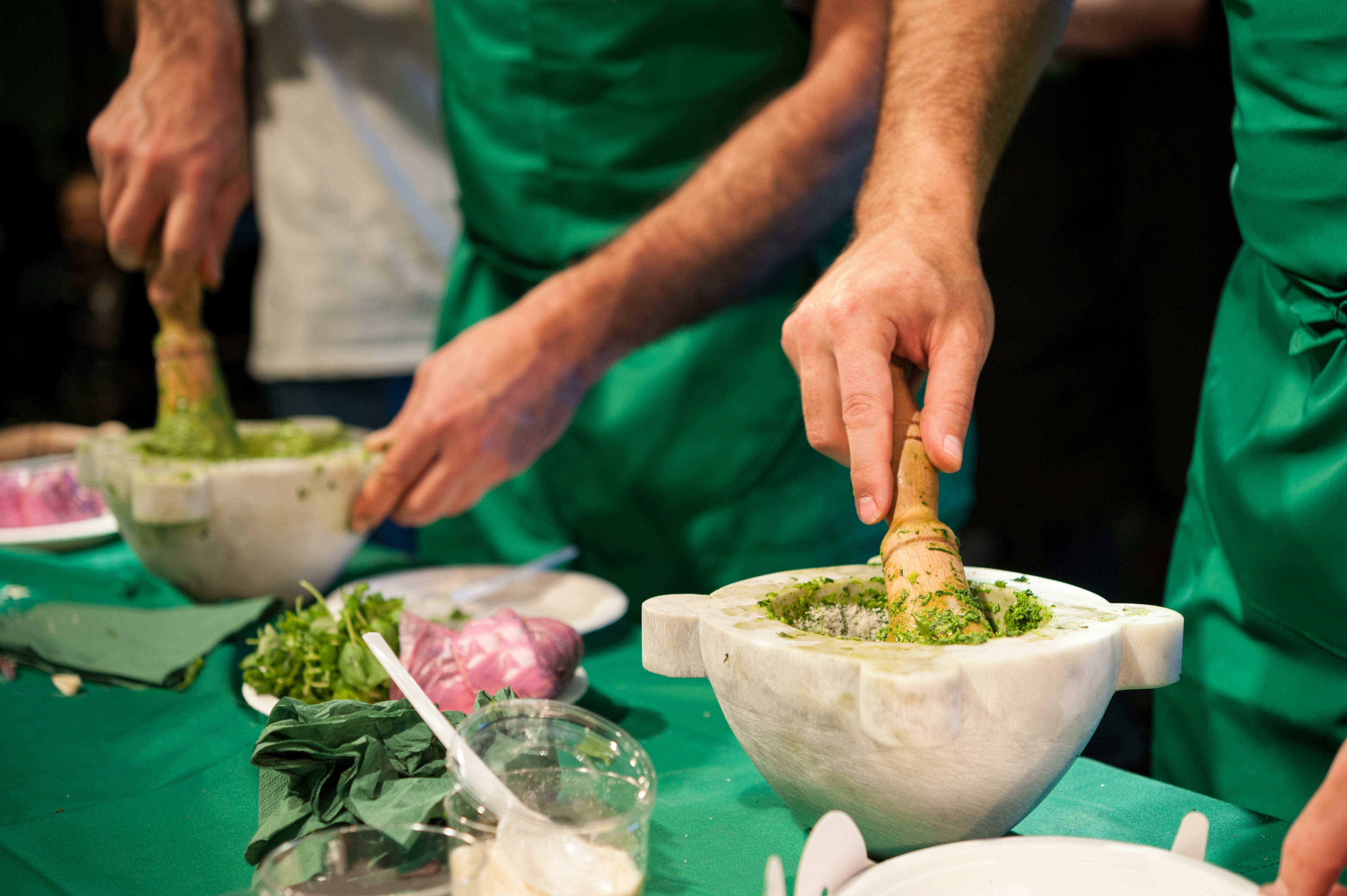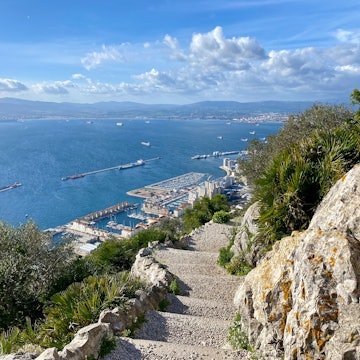

We've got all the essential info you need before your first trip to Genoa. Roberto Lo Savio/Getty Images
Many people use Genoa as an entry point to explore the Italian Riviera, including the famous (and often crammed) Portofino and Cinque Terre. But missing out on the charms of the city by rushing beyond it too soon would be a mistake.
Home to one of the largest medieval town centers in the world, crisscrossed with caruggi (narrow lanes) that beg to be discovered, the city is perfect for those who want to wander and get a little lost. Put your phone away and find out for yourself if a laneway leads to the bustling port, a 6th-century cathedral, a buzzing plaza where luck might snag you a table or, on occasion, right back to where you started.
My guide Cristiana Mondo describes Genoa as a “northern city with a southern lifestyle”. The pace of life – and the pace of strolling on the sidewalk – is notably slower and more enjoyable for it. Shops often close long enough to allow locals to linger over lunch, and dinner can be as late as 10pm. Take a deep breath, slow down and join the Genoese on a meander.

When should I go to Genoa?
With its northern climate, Genoa starts to warm up in May but rarely gets the kind of heatwaves that are becoming more common in southern Europe; average temperatures in July and August usually top out at 28°C (82°F).
The most popular time to visit Genoa is on one of their Rolli Days when the doors of the Palazzi dei Rolli are thrown open to the public. During these weekends, which happen twice a year, the city is packed with visitors hungry for a peek inside the palazzos (palaces) that make the city so famous. Many of these sumptuously decorated buildings are privately owned and inaccessible to the public at other times of the year.
Genoa is also home to a busy cruise port and its season generally runs from April to October. Sundays can be hectic as they're the most popular day for cruise ships to dock but the crowds tend to dissipate from 4pm onwards.
How long do I need in Genoa?
You should leave at least two days to fully explore the historic center – visit the main museums, get lost in the twisting caruggi, browse the independent shops and dawdle over aperitivos and convivial Ligurian restaurants.
However, the Genoan city boundaries stretch far beyond the old town. With four days, you could take the train to the suburb of Pegli to explore the fantastical Villa Durazzo Pallavicini Park, whose garden has been landscaped to represent an operatic journey through a path of purification, similar to Dante’s Divine Comedy (not to be confused with Villa Durazzo in Santa Margherita).
Or head to Nervi, a beachside promenade where you can enjoy the crashing waves and cliffsides without the tourist crush; instead your company will be the locals who come to stroll the promenade in the sunshine while eating slices of focaccia. Dip into the botanical gardens of Parchi di Nervi or the Galleria d’Arte Moderna if you need some relief from the sun.

Is it easy to get to and around Genoa?
Genoa has its own airport that's just a 20-minute drive from the city center or 30 minutes on the bus. It’s a compact building that is easy to navigate and generally visitors zip through when they land. There are frequent train connections with plenty of other major Italian cities (Milan is less than 2 hours away), as well as connections to Nice and Marseille.
The city also has an extremely active port for those that would prefer a more sustainable option than flying – there are direct ferry connections to Barcelona, Sardinia, Sicily, Corsica, Malta, Tunisia and even Tangier. It is also a frequent day stop (and starting point) for large cruise ships.
The old town is very walkable and best explored on foot with a sense of adventure and willingness to get lost in the laneways. It can be steep in parts so bring good walking shoes. Taxis are allowed to drive in if you need transport.
For other areas of the city, there are good bus links and you can use the AMT Genova app to buy bus, metro or funicular tickets in advance. Don’t miss a ride on one of the free public elevators – the Ascensore di Castelletto Levante has amazing views at the top and the Ascensore Castello d’Albertis-Montegalletto is a funicular that turns into an elevator.
Top things to do in Genoa
Discover art, concerts and aperitivos in palazzos
Genoa’s numerous palazzos are a treasure trove of cultural wealth. This UNESCO World Heritage site is made up of 42 buildings, which means there's something here for every type of traveler. Inside Palazzo Rosso’s famous red walls lies an art gallery with several Van Dyck portraits. Don’t miss the cozy, frescoed "alcove apartment", recently reopened after 40 years and, in stark contrast, the top-floor apartment that is one of the most lauded examples of mid-century design. It also occasionally hosts concerts, as does Palazzo Ducale.
Palazzo Bianco is another high-end museum, spanning European art history from the 12th to 18th century. As well as pieces by Caravaggio and Rubens and strong links with Flemish and Dutch artists from the 15th to 17th century, there are a large number of important works from Genoese artists, including Bernardo Strozzi, Giovanni Benedetto Castiglione and Luca Cambiaso.
For something completely different, head to Les Rouges Cucina & Cocktails in Palazzo Imperiale for an aperitivo under elaborate ceiling reliefs.
Follow the trail of historic shops
Genoa’s caruggi are full of unique, independent shops to discover and many of them have historical value too. The city maintains a register of botteghe storiche, which are all places that have existed for at least 70 years, though the oldest dates back to 1650.
Fashion fans will delight in the timeless luxury of Pescetto, a family-run business first established in 1899. The high-quality vintage shop upstairs has pieces dating back to the 1940s and the silk scarves draped in the window will have you reaching for your wallet.
Take a moment to stop by Italy’s oldest confectionary shop, Romanengo 1780 – even if you don’t have a sweet tooth, the display of rainbow-colored creations under the glass counters is worth a visit. Many of them are still made by hand and flavored with fruits or flowers.
The historical shops are not just about pretty things you can bring home; also on the list are barbers, butchers and pharmacies. Follow the themed itineraries online or keep an eye out for the signs as you wander the old town.

Hike to ancient forts and Roman aqueducts
The fortifications surrounding the town of Genoa are the longest in Europe. From the top of some of the summits, you can see the pre-Alps on one side and the sea on the other. For a more leisurely stroll, you can walk the length of a 2nd century Roman aqueduct starting from Cavassolo and heading back towards the town. The walk leaves you near the Staglieno Cemetery.
Stroll the Porto Antico
The bustling port is a hub of local activity, especially once the cruise ships depart in the evening. There are plenty of restaurants to try and popular spots by the water to have an aperitivo. Eataly has both a restaurant and a gourmet grocery store that are worth heading to if only to use the elevator and get a glimpse of the port from above. If you’re on a budget, simply grab a slice of focaccia and watch the sunset.
My favorite thing to do in Genoa
Leave aside at least half a day to explore the incredible Monumental Cemetery of Staglieno. It's famous for the hauntingly realistic sculptures that adorn the tombs of the 19th-century bourgeoise, a macabre competition in both art and memorials. You may recognize the Appiani family tomb from Joy Divison’s Closer album cover but I was most struck by the hyper-realistic sculpture of Caterina Campodonico, a street vendor who saved money from a lifetime of selling peanuts to commission her own memorial to sit among the city’s elite.
Away from the famous corridor galleries, there are plenty of other interesting graves to seek out, including Constance Wilde, wife of Oscar, who died in Genoa in 1898. The tourist office has a booklet on the cemetery including a very useful self-guided walking tour that provides valuable context (and directions!) if visiting by yourself.

What to eat in Genoa
Pesto comes with almost everything and it will almost certainly be the best pesto of your life. Some restaurants have their own handmade jars to sell or you can pick up delicious ones from Mercato Orientale, a bustling gastronomic haven full of stalls stuffed with local produce. If you want to try your hand at making your own (surprisingly easy, I promise), book a workshop at Creattivando and get creative in a kitchen within the sumptuous Palazzo Imperiale.
Focaccia is another famous specialty, with numerous kiosks offering takeaway slices to eat on the go while indulging in a spot of people-watching. Another great street food option is the farinata (a crispy, light snack made with chickpea flour).
Must-try restaurants in Genoa
Il Genovese: This cozy and traditional Ligurian restaurant is run by passionate chefs. Also featured in Stanley Tucci’s Searching for Italy.
20 Tre Restaurant: A mix of local specialties and inventive dishes served with a dash of artistic flair.
Trattoria Rosmarino: A local favorite, their hazelnut sauce pasta is deserving of seconds.
Cremeria Buonafede: A takeaway caffeteria specializing in ice cream. Try the panera, a coffee-flavored semifreddo (soft ice cream with the texture of lighter-than-air mousse).
Al fresco dining is not as common in Genoa as it is in other Mediterranean cities, although it is becoming more popular.
Where to sleep in Genoa
Staying in the old town is a really fun experience, although you should avoid dark and empty alleyways at night if you don’t know where you’re going. Your accommodation should be able to tell you the best route to take after dark. The shopping street XX Settembre has lots of accommodation on or near it that caters to a range of budgets.
Hostels are not very common in Genoa, so a self-catering apartment or hotel is your best bet. For a truly unique Genoan experience, there are a number of hotels located in former palazzos. I stayed at Hotel Palazzo Grillo, which combines modern, minimalist decor with lovingly restored original features from the 16th century and it's just minutes away from Porto Antico and Via Garibaldi. Locanda di Palazzo Cicala and Palazzo Zecchino are two other popular palazzo hotels.
Average costs in Genoa
Hostel dorm room: €38-44
Basic room for two: €120-170
Self-catering apartment (including Airbnb): €90-170
Bus ticket: €1.50
Espresso: €1.20
Slice of focaccia to-go: €2
Aperitivo cocktail: €7-10
Dinner for two (2 main courses and a bottle of wine): €65-90
AnneMarie visited Genoa on the invitation of Visit Genoa. Lonely Planet contributors do not accept freebies in return for positive coverage.
















